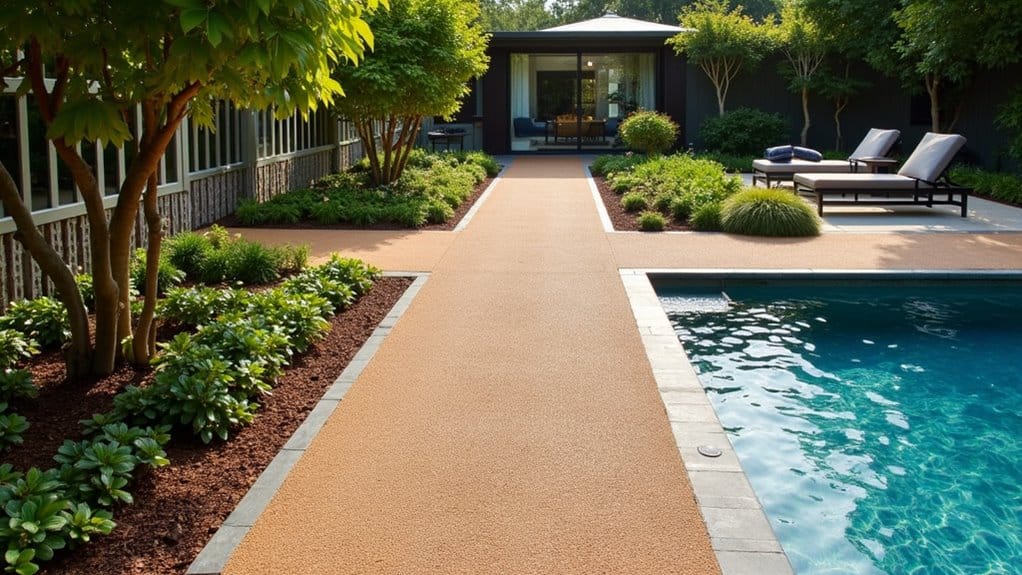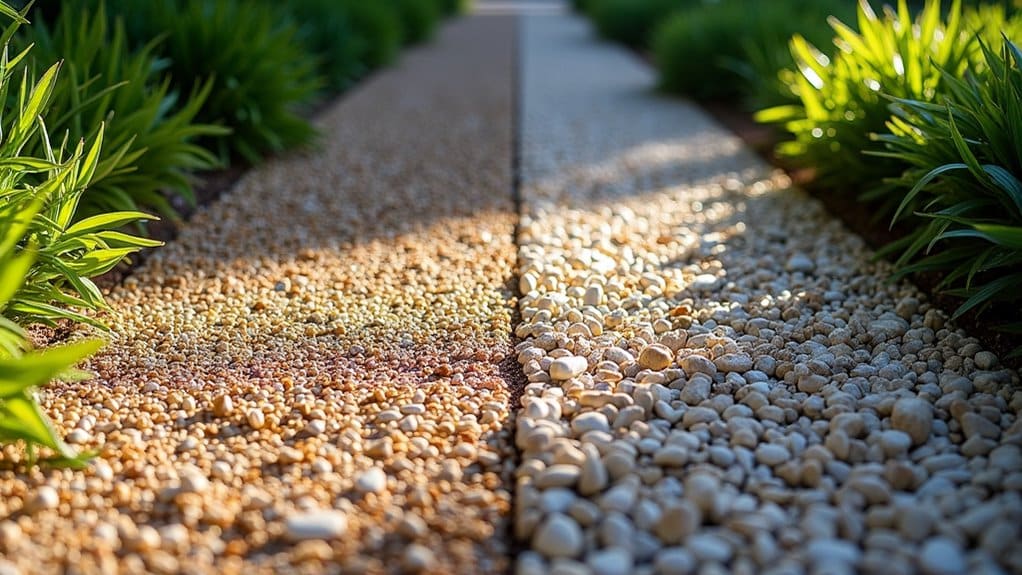A stone carpet is a flooring option that combines small stones or aggregates with a clear resin binder. This mixture not only offers a distinctive look but also improves durability and slip resistance. Stone carpets can be used both indoors and outdoors, making them a versatile choice for different environments. Their non-porous nature prevents moisture problems and makes maintenance easy, as they don’t require sealing. Ideal for high-traffic areas, stone carpets adapt seamlessly to the contours of the surface. If you’re interested in the specific advantages and installation methods for quartz flooring and stone carpets, there’s plenty more to explore.
Table of Contents
ToggleKey Takeaways
- Quartz flooring, made up of 90-95% quartz crystals, is known for its durability, visual appeal, and low maintenance, making it suitable for a variety of settings.
- A stone carpet is formed by mixing small stones with a clear resin binder, making it ideal for both indoor and outdoor spaces.
- Both quartz flooring and stone carpets are highly durable, slip-resistant, and work well with underfloor heating systems.
- Installing quartz and stone carpets requires careful surface preparation and professional assistance to achieve the best results.
- Maintenance is straightforward for both options; regular cleaning and prompt spill management are all that’s needed, with no requirement for sealing or recoating.
Definition of Quartz Floors
When exploring flooring options, quartz floors are notable for their unique composition and durability. Made from natural quartz sand blended with materials like calcium carbonate or synthetic resin, these floors are resistant to wear, stains, and chemicals. This makes them a great choice for high-traffic commercial areas and demanding environments such as kitchens and manufacturing sites. A key benefit of quartz flooring is the wide range of colour options available. From vibrant shades to understated tones, you can easily customise the look to fit your design preferences. The epoxy quartz system allows for tailored combinations, enhancing both functionality and aesthetics. Additionally, quartz is recognized as one of the hardest natural materials, which further contributes to its longevity in various applications.
Cost is an important factor to consider. Although the initial investment may be higher than some traditional flooring choices, the durability and low maintenance can result in savings over time. Additionally, quartz can be installed over existing surfaces, reducing demolition costs. Overall, quartz flooring is an appealing option, offering both visual appeal and practical advantages for various applications.
Composition of Quartz Flooring
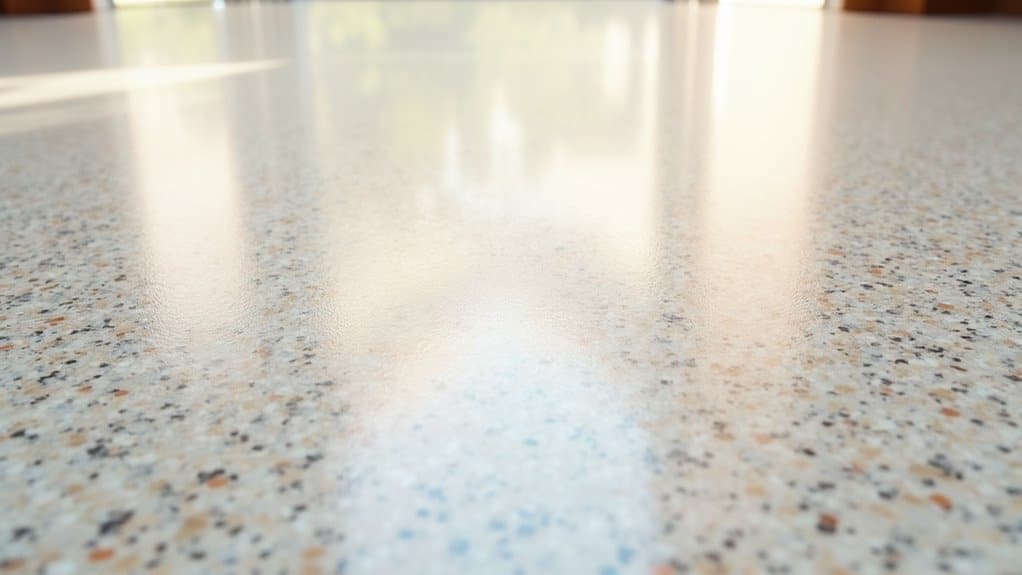
The composition of quartz flooring consists of 90-95% quartz crystals and 5-10% synthetic resin. This combination not only boosts durability but also creates a resilient surface that can handle heavy foot traffic. The engineering of these materials ensures strength and longevity, making quartz flooring a sensible choice for various settings, from homes to commercial spaces. Additionally, its low moisture absorption rate contributes to its effectiveness in wet areas, enhancing its suitability for a variety of environments.
Materials Used in Composition
To understand the composition of quartz flooring, it’s important to note that it mainly consists of a mix of high-quality quartz aggregates and robust resins.
Key materials include UV-stable coloured quartz aggregates, which ensure both durability and aesthetic appeal, alongside high-quality resins like epoxy or polyaspartic that provide a strong bond. The inclusion of quartz sand and calcium carbonate contributes to its hardness. Additionally, superior impact resistance is achieved through the use of colored quartz aggregates, enhancing the flooring’s performance in high-traffic areas.
You can personalise your quartz flooring with a wide array of coloured quartz blends to match your design vision.
The choice of resin types also broadens its functionality; for example, acrylic resin is ideal for certain indoor applications, whereas polyaspartic resin is fast-drying and suited for heavy-duty use.
Furthermore, natural stone elements like glass, marble, and granite can be added for extra texture and visual interest.
Engineering for Durability
Engineering quartz flooring for durability involves careful selection of materials and innovative techniques that enhance its performance. This flooring is built to withstand heavy loads and impacts, making it perfect for high-traffic areas.
Thanks to advancements in engineering, quartz floors offer remarkable flexibility, allowing them to resist thermal and physical stresses. Their chemical resistance ensures that harsh substances won’t penetrate or damage the surface, and they can handle drastic temperature changes, making them suitable for various climates. Additionally, the slightly textured surface provides slip resistance, enhancing safety in wet areas like swimming pools or bathrooms. Quartz flooring is also low-maintenance, so keeping it clean requires minimal effort. With a lifespan exceeding 25 years, it represents a cost-effective investment.
Moreover, the use of multi-layer systems significantly enhances its overall durability and performance. Installation is quick and straightforward, needing a stable base for optimal performance. Material innovations have significantly reduced the need for repairs or replacements, ensuring long-lasting durability.
This combination of features makes quartz flooring an excellent choice for both residential and commercial spaces, providing a seamless, enduring surface that meets a range of design requirements.
What Is a Stone Carpet?

A stone carpet is a stylish flooring option that blends small stones or aggregates with a clear resin binder, usually made up of around 96% natural materials such as granite or quartz. This versatile surface can be applied over existing floors using hand-trowelling techniques, making it suitable for both indoor and outdoor areas. Its durability and slip-resistant qualities, along with its attractive appearance, make it a great choice for high-traffic spaces and luxury settings alike. Additionally, this flooring system is known for its high durability and can withstand heavy foot traffic, ensuring longevity in various environments.
Composition and Materials
Stone carpets, made from a mix of coloured quartz stones and high-quality binders, provide a flooring solution that beautifully blends style with practicality.
The main component, coloured quartz granules, not only enhances the look but also adds durability and resistance to wear. With a hardness rating of 7, quartz is scratch- and stain-resistant, making it perfect for busy areas. Additionally, these stone carpets offer durable and slip-resistant surfaces, which contribute to their safety in various environments.
Binders are crucial in stone carpet composition. Options like epoxy resin, polyurethane, and polyaspartic resin effectively bond the quartz granules while offering added benefits. For example, polyurethane binders are UV resistant, helping to prevent discolouration in outdoor settings. Some manufacturers even use acrylic resin for its slip-resistant properties, which is ideal for wet spaces.
Stone carpets are versatile enough for both indoor and outdoor use, making them a fantastic choice for different applications.
With a grain size of 2-6 mm and a thickness of 6-8 mm, they offer a sturdy flooring option that requires minimal maintenance and ensures long-lasting performance.
Installation Techniques
Installing quartz flooring correctly is essential for a long-lasting and attractive finish. Start by thoroughly preparing the surface; ensure it’s clean and free from debris to avoid issues with the adhesive.
Check that the subfloor is level, as uneven surfaces can complicate the installation. If necessary, prime the subfloor to improve adhesion, and compact it if it’s made of soil or aggregate.
Once the surface is ready, mix the quartz flooring components according to the manufacturer’s guidelines. Spread the material evenly over the subfloor, being careful not to overwork it to maintain consistency. The durability of quartz flooring ensures it can withstand heavy foot traffic without damage.
Allow the quartz to cure for at least 24 hours before allowing foot traffic.
For quartz tiles, use a quality thin-set mortar and maintain appropriate joint spacing. If you’re working with heavier quartz slabs, consider adding extra support during installation.
Finally, apply a sealant to protect against stains and wear. By following these steps, you can ensure a successful installation that minimises potential problems and maximises the lifespan of your quartz flooring.
Benefits and Applications
When considering flooring options, stone carpet is notable for its durability, aesthetic appeal, and low maintenance. Made from a blend of quartz sand and calcium carbonate, it’s an eco-friendly choice that’s built to last, with a lifespan of over 25 years.
Stone carpet is highly versatile and can be customised for any setting, whether it’s a home kitchen, bathroom, or a commercial showroom. Its seamless finish adapts to various surface contours and offers a modern appearance while being slip-resistant, enhancing safety in busy areas.
Maintenance is simple since stone carpets don’t require sealing and are stain-resistant, much like traditional carpets. With over 1,000 colour options available, you can achieve a distinctive look.
Additionally, it’s compatible with underfloor heating systems, increasing its practicality. Whether for indoor or outdoor use, stone carpets provide a stylish, durable, and low-maintenance flooring solution that meets contemporary design and environmental standards.
Installation Process Overview
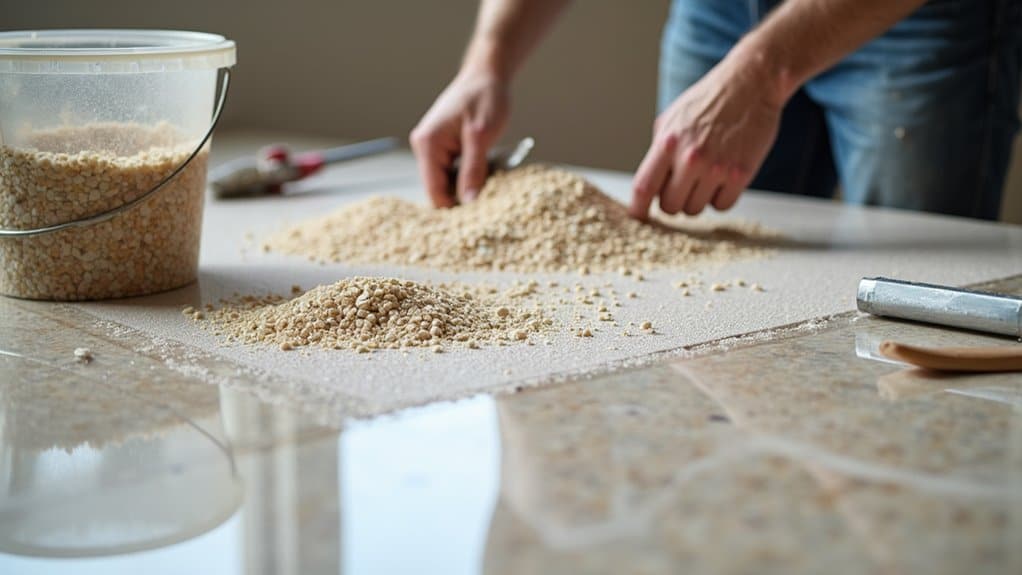
Installing quartz floors involves several essential steps to ensure a durable and attractive finish.
Begin with thorough surface preparation. Clean the substrate to remove dirt and old coatings. Level the subfloor by smoothing out any bumps and filling gaps, ensuring compatibility with your chosen quartz flooring. If needed, apply a primer to enhance adhesion.
Once the surface is prepared, mix your epoxy according to the manufacturer’s guidelines. Use a squeegee or roller to spread the epoxy evenly across the surface. While the epoxy is still wet, broadcast quartz granules evenly over the area. For a more controlled application, you can use a hand trowel to achieve a smooth finish without visible joints.
Allow the quartz sand epoxy floor to cure for the recommended time, usually between 12-24 hours.
If using a liquid quartz system, mix the resin and hardener as instructed. It’s advisable to consider professional installation, especially for larger projects or external applications, to ensure quality.
Benefits of Quartz Flooring

Choosing quartz flooring is a smart investment.
It boasts excellent durability, making it ideal for high foot traffic areas without showing signs of wear.
Its slip-resistant properties enhance safety, whether in homes or businesses.
Plus, maintenance is a breeze, allowing you to keep your floors looking great without the fuss of complicated cleaning routines.
Durability and Longevity
Quartz flooring is renowned for its durability, making it a top choice for both homes and businesses. Its high resistance to scratches, stains, and moisture ensures that your floors remain attractive and functional, even in busy areas. With proper care, quartz flooring can last over 25 years, making it a wise investment.
The versatility of quartz allows it to thrive in various settings, and its strong chemical resistance means that harsh substances won’t damage it. When looking at sustainability, quartz flooring requires minimal maintenance, which helps lower long-term costs and reduce environmental impact—making it a responsible option.
Installation is quick, with fast curing times that minimise disruptions, which is particularly beneficial for commercial spaces.
The high return on investment (ROI) is due to its durability and low maintenance needs, leading to fewer replacements and repairs. By choosing quartz flooring, you’re not only improving the look of your space but also securing a sturdy, long-lasting solution that’s mindful of costs.
Slip Resistance Features
Homeowners and business owners value the slip-resistant features of quartz flooring, which enhance safety in various settings. Quartz floors use slip-resistant materials, like quartz aggregate, to create a textured surface that significantly lowers the risk of slips and falls. This is especially important in high-moisture areas such as kitchens, bathrooms, and commercial spaces.
You can tailor the level of slip resistance to suit your needs and preferences. Slip resistance testing ensures that the flooring meets safety standards, making quartz a better option than ceramic tiles or terrazzo. Additionally, slip-resistant coatings or treatments can be applied to polished quartz without compromising its appearance, further enhancing traction.
The slip resistance of quartz flooring is particularly advantageous in environments catering to vulnerable groups, such as hospitals and care homes. With around 6,000 deaths occurring each year in the UK due to falls at home, investing in slip-resistant flooring is a crucial safety measure.
Quartz flooring not only provides a secure surface but also complies with the Equality Act, making it a sensible choice for any space.
Easy Maintenance Solutions
Maintaining quartz flooring is simple due to its non-porous nature and robust composition. You only need neutral cleaning products to keep your floors looking immaculate, so regular cleaning is crucial, particularly in busy areas.
Establish maintenance routines to ensure dirt and stains are dealt with quickly, as frequent cleaning helps prevent buildup and extends the life of your flooring.
For minor scratches, a cleaner/maintainer can be effective; it cleans and seals imperfections while keeping a consistent shine. If spills happen, wipe them up immediately with warm water to avoid staining or damage.
Quartz flooring is durable, resisting scratches, stains, and moisture, making it perfect for high-traffic environments. Enhanced with polyurea coatings, these floors can endure chemicals and UV exposure, making the cleaning process even easier.
There’s no need for recoating or sealing, which makes quartz flooring low-maintenance. This cost-effective solution not only saves time and money but also offers a stylish, long-lasting flooring option that blends effortlessly with various design styles.
Advantages of Stone Carpet

Stone carpets provide an excellent blend of durability and visual appeal, making them a superb flooring option for various settings. Their robust nature allows them to withstand heavy foot traffic, resist scratches, and handle spills effectively, making them ideal for busy areas such as commercial spaces and hotels.
Additionally, they’re moisture-resistant, which is particularly beneficial in bathrooms and kitchens.
On the aesthetic front, stone carpets add a unique and luxurious touch to any room. With a diverse range of colours and textures available, they can easily enhance both indoor and outdoor spaces. You also have the option to customise designs to reflect your personal style, keeping in line with the latest trends.
Safety and hygiene are significant benefits too. The textured surface offers excellent slip resistance, which helps reduce accidents in both homes and public areas.
Their non-porous nature resists mould and mildew, contributing to a healthier living environment. Moreover, stone carpets are eco-friendly; they’re made from natural materials that are recyclable, supporting your sustainability goals.
Maintenance Tips for Quartz Floors
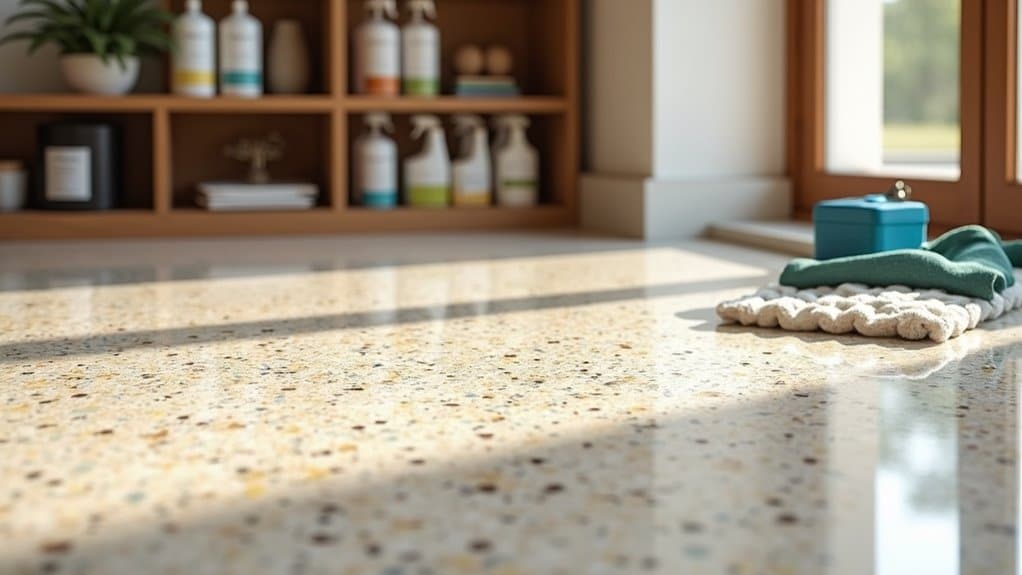
To keep your quartz floors in top condition, it’s important to have a regular cleaning routine. Here’s a straightforward guide for maintaining your quartz floors:
| Task | Recommendation |
|---|---|
| Daily Cleaning | Use a neutral cleaner or mild dish soap with warm water. |
| Spill Management | Wipe up spills immediately with warm water to avoid stains. |
| Stain Treatment | For stubborn stains, opt for pH-neutral cleaners or a vinegar solution. |
| Soft Cloth Usage | Always use soft cloths or sponges to prevent scratches. |
| Preventative Steps | Place mats in busy areas and avoid dragging heavy items. |
Make sure to dry your floors after cleaning to prevent streaks. Although quartz is non-porous and resistant to most stains, it still needs care. Steer clear of harsh chemicals and abrasive sponges, as these can harm the surface. For tough stains, consider seeking professional assistance. By following these tips, you can keep your quartz floors looking beautiful and lasting for years.
Durability of Quartz and Stone Carpet

Durability is one of the standout benefits of quartz and stone carpet, making them excellent choices for both homes and businesses. Quartz flooring can handle extreme temperature shifts, remaining stable even in sunny areas. Its high resistance to chemicals reduces the risk of damage, and with a lifespan of over 25 years, it offers impressive long-term durability.
Unlike natural stone, whose durability can fluctuate based on environmental conditions, quartz consistently maintains its strength.
When comparing costs, quartz is more economical in the long run due to its low maintenance needs and resistance to cracking. For example, while vinyl flooring typically lasts just 10-20 years and requires regular upkeep, quartz stands up well against heavy foot traffic. Its non-porous surface also prevents moisture-related issues, further bolstering its durability.
From an environmental perspective, the longevity and low maintenance of quartz flooring help reduce its carbon footprint, as it doesn’t need replacing as frequently as other options.
With its flexibility and design versatility, quartz provides a durable flooring solution without sacrificing style, distinguishing it from alternatives like epoxy and tile flooring.
Applications of Quartz Flooring
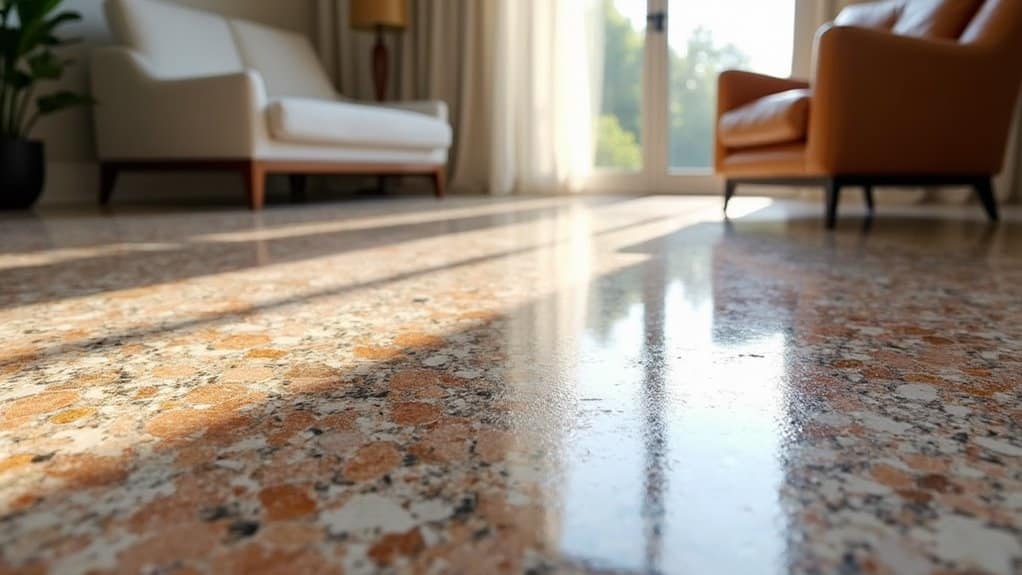
Quartz flooring is incredibly versatile, making it an excellent choice for a range of applications in various settings. It suits both residential and commercial environments, enhancing both aesthetics and functionality. You can use it indoors or outdoors, from driveways to kitchens, as well as in high-traffic areas like hotels and garages.
Here’s a simple overview of key applications:
| Setting | Type | Benefits |
|---|---|---|
| Residential | Indoor/Outdoor | Attractive design, slip resistance |
| Commercial | High-traffic areas | Long-lasting, low maintenance |
| Industrial | Manufacturing facilities | Resistant to chemicals, quick to install |
Quartz flooring can be installed over existing surfaces, reducing downtime. Its seamless finish not only looks great but also makes cleaning easier. With a variety of colours and textures available, you can tailor it to fit your design vision. Plus, it’s compatible with underfloor heating systems and is UV resistant, making it suitable for a wide range of applications.
Versatility of Stone Carpet

When it comes to flooring options, stone carpets are a top choice thanks to their versatility and visual appeal. They come in a wide range of colours and textures, suitable for both modern and traditional settings. You can combine different stone types like marble, granite, and slate to create a unique look that reflects your personal style.
One of the great benefits of stone carpets is their adaptability for installation. They can be used in various settings, both indoors and outdoors. Their lightweight nature makes them easy to transport and install, and they fit well over different subfloor types without needing extensive adjustments.
You can even lay them over existing surfaces with minimal preparation, saving you time and hassle.
Moreover, stone carpets provide excellent slip resistance and help reduce noise, making your space safer and more comfortable. With minimal maintenance and the durability to handle heavy foot traffic, these carpets not only enhance your property’s aesthetics but also offer long-lasting value.
Technical Specifications Explained

When looking at the technical specifications of quartz floors, their composition is crucial for performance and durability. Made up of 93-95% pure quartz, along with 5-7% high-quality polyester or natural resin and 1% pigment, these floors are exceptionally tough. They resist abrasion, acids, oils, and liquids, ensuring they retain their appearance over time.
With low water absorption and impressive flexural strength, quartz floors are a standout option.
For installation, it’s essential to have a dry, stable subfloor that’s free from contaminants. The base should be solid and level, with no more than 3mm variation over 3m. Available in tiles and slabs, quartz floors offer a range of aesthetic choices to match different design styles.
Sustainability is another benefit, as quartz floors are long-lasting, reducing the need for frequent replacements. With a compressive strength of at least 20,685 kPa and water absorption below 0.02%, they not only provide durability but also support eco-friendly building practices.
Design Options for Quartz Floors

Choosing the right design options for your flooring can significantly enhance the look of any space. With quartz floors, you can customise various elements to ensure your flooring matches your design vision.
- Colour Selection: You can opt for standard blends or create custom mixes, offering a vast range of colours. Neutral tones with subtle variations enhance flexibility.
- Texture Options: Quartz tiles are available in both smooth and textured surfaces, allowing you to choose anti-slip features for safety without compromising on style.
- Patterns and Shapes: The modular tile system allows for unique patterns that can transform a floor into a striking feature. Different shapes and sizes can be combined to create captivating visual effects.
Finishes can also be tailored to meet specific environmental needs, ensuring durability alongside aesthetic appeal.
Whether you prefer a seamless finish or distinct tile lines, the variety of options available enables you to achieve your desired look while enjoying a robust flooring solution.
Frequently Asked Questions
How Long Does Quartz Flooring Last With Proper Maintenance?
With proper maintenance, quartz flooring can last between 15 and 20 years. To ensure its longevity, prioritise quality during installation, maintain a regular cleaning routine, and take precautions to prevent damage. For example, placing mats at entryways can help reduce wear and tear from dirt and grit. By following these simple steps, you can keep your quartz flooring looking great for years to come.
Can Quartz Flooring Be Installed Outdoors?
Can quartz flooring withstand the weather? Yes, but it’s essential to use proper installation methods for outdoor longevity. Opt for UV-stable options and consider placing it in shaded areas to reduce the risk of discolouration and cracking over time.
Is Quartz Flooring Safe for Children and Pets?
Yes, quartz flooring is safe for children and pets. Its slip-resistant surface helps prevent accidents, making it a practical choice for busy households. Additionally, it’s durable and easy to clean, ensuring a safe environment for your family. With quartz flooring, you can enjoy a long-lasting and low-maintenance option for your home.
What Colors Are Available for Stone Carpet?
With over 4,000 colour variations, you have a wealth of design options for your stone carpet. Standard shades such as White Sand and Slate are readily available, and you can also customise colours to suit your specific project requirements.
How Does Quartz Flooring Compare to Traditional Tiles?
When comparing quartz flooring to traditional tiles, you’ll find it offers greater design flexibility with a wide range of colours available. The installation is more straightforward, requiring less preparation and no sealing, making it a practical option for various spaces. For instance, if you’re renovating a kitchen or bathroom, quartz can provide a seamless look that’s both modern and low-maintenance.
Conclusion
In conclusion, quartz floors and stone carpets combine durability with aesthetic charm, much like a beautiful painting enhances a room. By opting for quartz flooring, you’re investing in a surface that not only looks good but is also versatile and low-maintenance. It stands the test of time, making it a practical choice for any space. Embrace the elegance and strength of quartz, and let your floors reflect both beauty and resilience in every step.
Prepare the perfect base for your resin bound stone installation and discover the crucial factors that ensure lasting durability.
Know where resin bound surfacing can transform spaces for both residential and commercial use, and discover the countless benefits that Read more
Learn the key differences between resin bound and resin bonded gravel to discover which surfacing solution best suits your needs Read more



